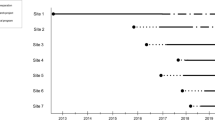Abstract
Community-based clergy are highly engaged in helping seriously ill patients address spiritual concerns at the end of life (EOL). While they desire EOL training, no data exist in guiding how to conceptualize a clergy-training program. The objective of this study was used to identify best practices in an EOL training program for community clergy. As part of the National Clergy Project on End-of-Life Care, the project conducted key informant interviews and focus groups with active clergy in five US states (California, Illinois, Massachusetts, New York, and Texas). A diverse purposive sample of 35 active clergy representing pre-identified racial, educational, theological, and denominational categories hypothesized to be associated with more intensive utilization of medical care at the EOL. We assessed suggested curriculum structure and content for clergy EOL training through interviews and focus groups for the purpose of qualitative analysis. Thematic analysis identified key themes around curriculum structure, curriculum content, and issues of tension. Curriculum structure included ideas for targeting clergy as well as lay congregational leaders and found that clergy were open to combining resources from both religious and health-based institutions. Curriculum content included clergy desires for educational topics such as increasing their medical literacy and reviewing pastoral counseling approaches. Finally, clergy identified challenging barriers to EOL training needing to be openly discussed, including difficulties in collaborating with medical teams, surrounding issues of trust, the role of miracles, and caution of prognostication. Future EOL training is desired and needed for community-based clergy. In partnering together, religious–medical training programs should consider curricula sensitive toward structure, desired content, and perceived clergy tensions.

Similar content being viewed by others
References
Abrams, D. (2005). The Florida clergy end-of-life education enhancement project—a description and evaluation. American Journal of Hospice and Palliative Medicine, 22(3), 181–187.
Alcorn, S. R., et al. (2010). “If God wanted me yesterday, I wouldn’t be here today”: religious and spiritual themes in patients’ experiences of advanced cancer. Journal of Palliative Medicine, 13(5), 581–588.
Balboni, T. A., et al. (2007). Religiousness and spiritual support among advanced cancer patients and associations with end-of-life treatment preferences and quality of life. Journal of Clinical Oncology, 25(5), 555–560.
Balboni, T. A., et al. (2010). Provision of spiritual care to patients with advanced cancer: associations with medical care and quality of life near death. Journal of Clinical Oncology, 28(3), 445–452.
Balboni, M. J., et al. (2011). “It depends”: viewpoints of patients, physicians, and nurses on patient-practitioner prayer in the setting of advanced cancer. Journal of Pain and Symptom Management, 41(5), 836–847.
Balboni, T. A., et al. (2013a). Provision of spiritual support to patients with advanced cancer by religious communities and associations with medical care at the end of life. JAMA Internal Medicine, 173(12), 1109–1117.
Balboni, M. J., et al. (2013b). Why is spiritual care infrequent at the end of life? Spiritual care perceptions among patients, nurses, and physicians and the role of training. Journal of Clinical Oncology, 31(4), 461–467.
Balboni, M. J., et al. (2017). U.S. clergy religious values and relationships to end-of-life discussions and care. Journal of Pain and Symptom Management, 53(6), 999–1009.
Balboni, M. J., et al. (2018). The views of clergy regarding ethical controversies in care at the end of life. Journal of Pain and Symptom Management, 55(1), 65–74.
Crabtree, B. F., & Miller, W. L. (1999). Doing qualitative research (2nd ed.). Thousand Oaks, CA: Sage Publications.
LeBaron, V. T., et al. (2015). Clergy views on a good versus a poor death: ministry to the terminally ill. Journal of Palliative Medicine, 18(12), 1000–1007.
LeBaron, V. T., et al. (2016). How community clergy provide spiritual care: Toward a conceptual framework for clergy end-of-life education. Journal of Pain and Symptom Management, 51(4), 673–681.
Malterud, K. (2001). Qualitative research: Standards, challenges, and guidelines. Lancet, 358(9280), 483–488.
Norris, K., et al. (2004). Spiritual care at the end of life. Some clergy lack training in end-of-life care. Health Progress, 85(4), 34–39.
Payne, R., et al. (2006). Key Topics on End-of-Life Care for African Americans. https://divinity.duke.edu/sites/divinity.duke.edu/files/documents/tmc/KTFULL.pdf. Accessed 28 May 2018.
Phelps, A. C., et al. (2012). Addressing spirituality within the care of patients at the end of life: perspectives of patients with advanced cancer, oncologists, and oncology nurses. Journal of Clinical Oncology, 30(20), 2538–2544.
Rodriguez, E., et al. (2011). An educational program for spiritual care providers on end of life care in the critical care setting. Journal of Interprofessional Care, 25(5), 375–377.
Sanders, J. J., et al. (2017). Seeking and accepting: U.S. clergy theological and moral perspectives informing decision making at the end of life. Journal of Palliative Medicine, 20(10), 1059–1067.
Saultz, J. W., & Kliewer, S. (2006). Healthcare and spirituality. Oxford, UK: Radcliffe Publishing.
Williams, M. L., et al. (2006). How well trained are clergy in care of the dying patient and bereavement support? Journal of Pain and Symptom Management, 32(1), 44–51.
Funding
The study was made possible by the National Cancer Institute (NCI) #CA156732, the John Templeton Foundation, the Issachar Fund, and the Harvard Program on Integrative Knowledge and Human Flourishing.
Author information
Authors and Affiliations
Corresponding author
Rights and permissions
About this article
Cite this article
Koss, S.E., Weissman, R., Chow, V. et al. Training Community Clergy in Serious Illness: Balancing Faith and Medicine. J Relig Health 57, 1413–1427 (2018). https://doi.org/10.1007/s10943-018-0645-8
Published:
Issue Date:
DOI: https://doi.org/10.1007/s10943-018-0645-8




